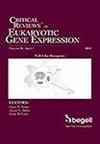Glycosaminoglycans (GAGs) adenogenesis factors: immunohistochemical espression in endometriosis tissues compared to the endometrium
IF 1.6
4区 医学
Q4 BIOTECHNOLOGY & APPLIED MICROBIOLOGY
Critical Reviews in Eukaryotic Gene Expression
Pub Date : 2024-09-01
DOI:10.1615/critreveukaryotgeneexpr.2024054273
引用次数: 0
Abstract
Endometriosis is a chronic inflammatory pathology estrogen-dependent. It is a condition affecting 5%–10% of women of reproductive age worldwide. Recent evidence indicating an embryological origin of endometriosis has provided new insights into its pathogenesis and potential therapeutic approaches. In this study, we compared the immunohistochemical expression of extracellular matrix molecules involved in the interaction between epithelium and stroma in endometriotic lesions and normal endometrial tissue. A total of 41 cases were analyzed. We examined the immunohistochemical expression of Chondroitin sulfate proteoglycan 4 (CSPG4), Keratan sulfate, Chondroitin sulfate (CS-56), Hyaluronic acid, and Heparan sulfate (HEP). Our results showed higher expression of CSPG4 and CS-56 in epithelial endometriosis samples compared to normal endometrial tissue, while HEP, Keratan sulfate, and Hyaluronic acid showed decreased expression in epithelial endometriosis samples relative to normal endometrial tissue. Additionally, endometriotic stroma exhibited more frequent low intensity of Hyaluronic acid and HEP compared to normal endometrial stroma. Investigating the levels of these molecules in eutopic and ectopic endometrial tissues enables the identification of potential therapeutic targets and the development of novel treatments aimed at disrupting the adhesive and invasive properties of endometriotic lesions.糖胺聚糖(GAGs)腺生成因子:与子宫内膜相比,在子宫内膜异位症组织中的免疫组化表达
子宫内膜异位症是一种依赖雌激素的慢性炎症性病变。全世界有 5%-10%的育龄妇女患有此病。最近有证据表明,子宫内膜异位症起源于胚胎学,这为我们了解其发病机制和潜在的治疗方法提供了新的视角。在这项研究中,我们比较了子宫内膜异位症病变和正常子宫内膜组织中参与上皮和基质相互作用的细胞外基质分子的免疫组化表达。我们检测了硫酸软骨素蛋白多糖 4(CSPG4)、硫酸角叉菜胶、硫酸软骨素(CS-56)、透明质酸和硫酸肝素(HEP)的免疫组化表达。我们的研究结果表明,与正常子宫内膜组织相比,上皮性子宫内异位症样本中 CSPG4 和 CS-56 的表达量较高,而 HEP、硫酸角叉菜胶和透明质酸在上皮性子宫内异位症样本中的表达量较正常子宫内膜组织有所下降。此外,与正常子宫内膜基质相比,子宫内膜异位症基质中透明质酸和 HEP 的表达强度更低。研究这些分子在异位和异位子宫内膜组织中的水平有助于确定潜在的治疗靶点,并开发旨在破坏子宫内膜异位症病变的粘附性和侵袭性的新型疗法。
本文章由计算机程序翻译,如有差异,请以英文原文为准。
求助全文
约1分钟内获得全文
求助全文
来源期刊

Critical Reviews in Eukaryotic Gene Expression
生物-生物工程与应用微生物
CiteScore
2.70
自引率
0.00%
发文量
67
审稿时长
1 months
期刊介绍:
Critical ReviewsTM in Eukaryotic Gene Expression presents timely concepts and experimental approaches that are contributing to rapid advances in our mechanistic understanding of gene regulation, organization, and structure within the contexts of biological control and the diagnosis/treatment of disease. The journal provides in-depth critical reviews, on well-defined topics of immediate interest, written by recognized specialists in the field. Extensive literature citations provide a comprehensive information resource.
Reviews are developed from an historical perspective and suggest directions that can be anticipated. Strengths as well as limitations of methodologies and experimental strategies are considered.
 求助内容:
求助内容: 应助结果提醒方式:
应助结果提醒方式:


